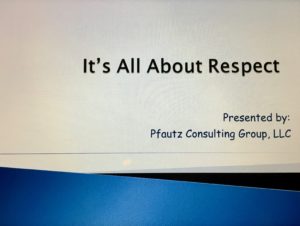Aretha Franklin sang about it. R-E-S-P-E-C-T. In her hit song, she asked for only a little of it. But, do we need more than just a little respect in the workplace? The #MeToo movement is shining a spotlight on sexual harassment in the workplace, and incidences of other toxic workplace behavior is on the rise. Harassment (sexual and otherwise), and other toxic workplace behavior, starts with a lack of respect. So, maybe we do need more respect in the workplace.
Respect can be defined as consideration for self and others. Let’s take a look at what a culture of respect looks like.
Respect includes consideration for other people’s privacy, their physical space and belongings, different viewpoints, opinions and philosophies, and different physical abilities, beliefs, personalities and characteristics.
In a respectful workplace, we value each other. Communication is kind, open and honest. And do you remember the golden rule? We treat people the way we wish to be treated. When we practice respect, we address conflict in a positive and respectful manner. Further, we address disrespectful behavior in the moment. As a result, we improve the work environment. Everyone in the workplace can help to influence a culture of respect – and everyone benefits.
In a respectful environment, we:
- actively listen to each other;
- make a genuine effort to understand and appreciate each other’s points of view;
- encourage and support each other’s ideas;
- congratulate and thank each other – and apologize when we need to;
- respect each other’s privacy and boundaries;
- collaborate and share credit;
- include and treat everyone the same – despite our differences.
In addition, in a respectful environment, we:
- don’t criticize or put down, especially in public;
- avoid generalizations and stereotypes;
- don’t blame, backstab or pass the buck;
- watch our language and keep off color jokes out of the workplace;
- don’t judge, gossip, spread rumors or take things that don’t belong to us (remember those Doritos in the break room?).
And rather than stewing, getting angry, or distracting other team members, we deal with any conflicts that do arise in a constructive manner – talking openly, honestly, calmly and directly.
Because a culture of respect is kind, fair and positive, it leads to a less distracting and more productive environment. Also, when everyone is comfortable expressing ideas and making suggestions, we learn from each other and create solutions and improve processes. Since we feel that who we are, and what we contribute as an individual, is important, we are more engaged. Most of all, a culture of respect offers a judgement-free and safe environment that satisfies our need for belonging and appreciation.
In a culture where respect is the guiding principle, employees protect each other. First, we can demonstrate respectful behavior ourselves. In addition, we can refuse to participate in any disrespectful behavior that we witness. But, we can also speak up and challenge the disrespectful behavior that we witness. Consequently, we help create an environment where disrespect is considered inappropriate and no one condones or tolerates it.
In our next blog, we’ll discuss how a lack of respect can manifest itself in the workplace.
Pfautz Consulting Group, LLCs “It’s All About Respect” workshops address respect, bullying, harassment and sexual harassment, and
- teach managers and employees the benefits of a respectful workplace;
- provide specific examples of what respect, disrespect and harassment looks like in the workplace (verbal, non-verbal, visual and physical);
- provide and discuss scenarios that demonstrate the issues;
- share solutions for challenging disrespectful and harassing behavior;
- discuss prevention strategies; and
- highlight employee and employer responsibilities.
If Pfautz Consulting Group, LLC can help you with your commitment to promoting a respectful workplace that is free from sexual and other unlawful harassment, please contact us.
Submitted by Deborah M McCormick

